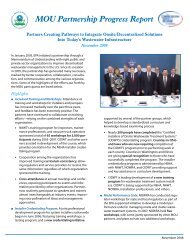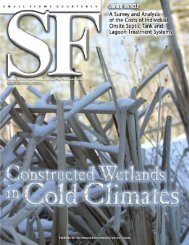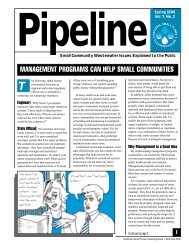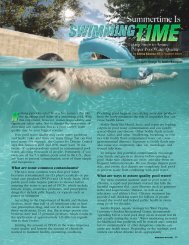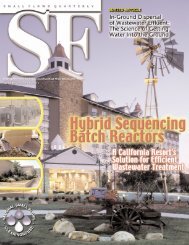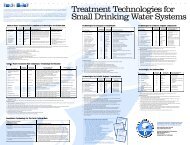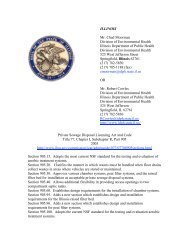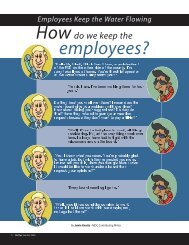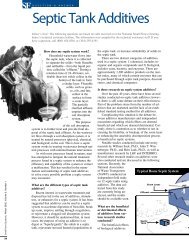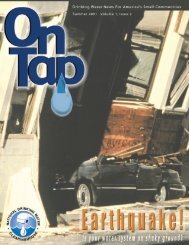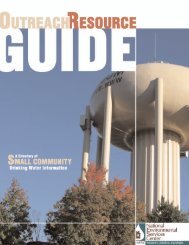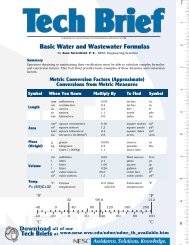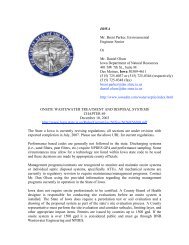Craig Mains | Technical Assistant - National Environmental Services ...
Craig Mains | Technical Assistant - National Environmental Services ...
Craig Mains | Technical Assistant - National Environmental Services ...
Create successful ePaper yourself
Turn your PDF publications into a flip-book with our unique Google optimized e-Paper software.
In recent years, the word “green” has become synonymous<br />
with the environment. Cars, cleaning products,<br />
and even certain laptops can be considered green if they<br />
are environmentally friendly. But the green movement<br />
hasn’t stopped there; it has also become an integral part<br />
of numerous communities across the U.S.<br />
Seattle, Washington, for instance, installed 16<br />
stepped, vegetated cells to collect stormwater runoff from<br />
approximately 72 acres. Monitoring results showed a 75-<br />
to 80-percent reduction in total runoff and a 60-percent<br />
reduction in peak flows. Other communities that have<br />
successfully developed green infrastructure include<br />
Chicago, Illinois; Portland, Oregon; Philadelphia and<br />
Pittsburgh, Pennsylvania; and Milwaukee, Wisconsin.<br />
With the passage of the American Recovery and Reinvestment<br />
Act (ARRA), even more communities will be<br />
going green.<br />
American Recovery and<br />
Reinvestment Act<br />
On February 17, 2009, President Obama signed<br />
ARRA into law. Its objectives, relative to state revolving<br />
funds, are, “to preserve and create jobs and promote<br />
economic recovery, … to provide investments needed to<br />
increase economic efficiency by spurring technological<br />
advances in science and health, …to invest in transportation,<br />
environmental protection, and other infrastructure<br />
that will provide long-term economic benefit…,” according<br />
to a March 2, 2009, memorandum from James A. Hanlon,<br />
director of the U.S. <strong>Environmental</strong> Protection<br />
Agency’s (EPA) Office of Wastewater Management and<br />
Cynthia Dougherty, director of EPA’s Office of Ground<br />
Water and Drinking Water.<br />
ARRA funds will increase the amount of money that is<br />
available through state revolving funds. Congress appropriated<br />
$4 billion for the Clean Water State Revolving<br />
Fund (CWSRF) and $2 billion for the Drinking Water<br />
State Revolving Fund (DWSRF) in addition to its annual<br />
appropriation. EPA began issuing grants at the end of<br />
March 2009, and these funds are available through September<br />
30, 2010.<br />
ARRA Special Conditions<br />
Under ARRA, 20 percent of the CWSRF and of the<br />
DWSRF must be used for the Green Project Reserve<br />
(see below), and these projects must be under contract<br />
or construction by February 17, 2010. “The idea is that<br />
Congress believes that economic circumstances are so<br />
dire that there is a need to move this money into the<br />
economy to get these projects going and create jobs,”<br />
says Peter Shanaghan, team leader with EPA’s Drinking<br />
Water State Revolving Fund.<br />
“In addition, projects must use American-made iron,<br />
steel, and manufactured goods for construction (there are<br />
waivers if a product is not available in America) and pay<br />
prevailing wage rates as federally required under the<br />
Davis-Bacon Act. Finally, because of the economic hardships<br />
facing many states and communities, states must<br />
provide at least 50 percent of their total capitalization<br />
grant in the form of additional subsidy, which can be for<br />
principle forgiveness, negative interest, or grants.” This is<br />
in addition to SRF subsidies already taken. For example,<br />
if a state receives $100 million, at least $50 million of the<br />
funding from the grant would have to be provided as an<br />
additional subsidy, and $20 million would have to be provided<br />
for the Green Project Reserve.<br />
What is the green project reserve?<br />
There are four categories of projects that fall under<br />
the Green Project Reserve. They are:<br />
1. green (stormwater) infrastructure (technologies, and<br />
practices that use natural systems – or engineered<br />
systems that mimic natural processes – to enhance<br />
overall environmental quality and provide utility services<br />
such as green roofs, rain gardens, and alternative<br />
sources of energy),<br />
2. energy efficiency (projects that substantially<br />
reduce energy consumption or produce clean energy),<br />
3. water efficiency (reuse or conservation projects that<br />
deliver equal or better services using less water), and<br />
4. innovative environmental projects (projects that manage<br />
water resources to prevent or remove pollution in<br />
an economically sustainable way).<br />
“Some examples of CWSRF Green Project Reserve<br />
projects are stormwater rain gardens; water reuse systems;<br />
wetland restoration; or replacing failed decentralized<br />
wastewater treatment systems with better onsite or<br />
cluster systems,” says Stephanie vonFeck, Green Project<br />
Reserve Team, USEPA, CWSRF Branch. Some examples<br />
of DWSRF Green Project Reserve projects include<br />
installing new water meters in previously unmetered systems,<br />
purchasing leak detection equipment, and improving<br />
onsite facilities, such as installing green roofs for<br />
stormwater runoff control and porous pavements.<br />
“An entire project or just the ‘green’ components of an<br />
SRF eligible project may count toward the 20-percent<br />
Green Project Reserve,” says vonFeck. “Projects can be<br />
stand-alone; they do not have to be part of a larger capital<br />
improvement project.” Communities or utilities that are<br />
interested in receiving assistance for a project must contact<br />
their state SRF programs to be placed on the state’s<br />
priority list for funding.<br />
Making Your Case to Fund Traditional<br />
Projects Under Green Project Reserve<br />
Some traditional projects that are green-related may<br />
also qualify toward the 20 percent Green Project Reserve.<br />
For example, lower friction provided by a new<br />
water distribution pipe could reduce the energy needed<br />
to pump water through the distribution system. But before<br />
the project can be counted toward the Green Project Reserve,<br />
communities must develop a business case. A<br />
business case is documentation of the reason a project<br />
or project component qualifies for the Green Project Reserve.<br />
A business case does this by identifying, both<br />
technically and financially, substantial green benefits.<br />
17




